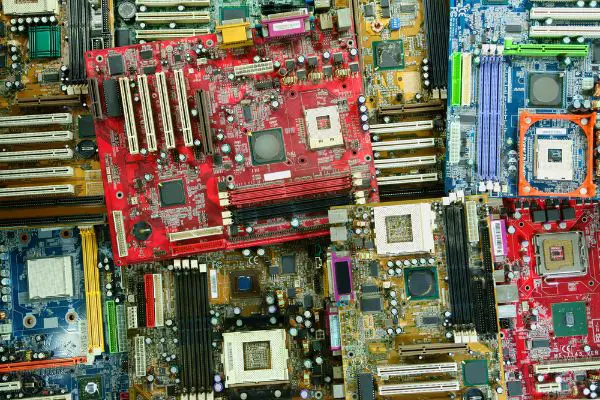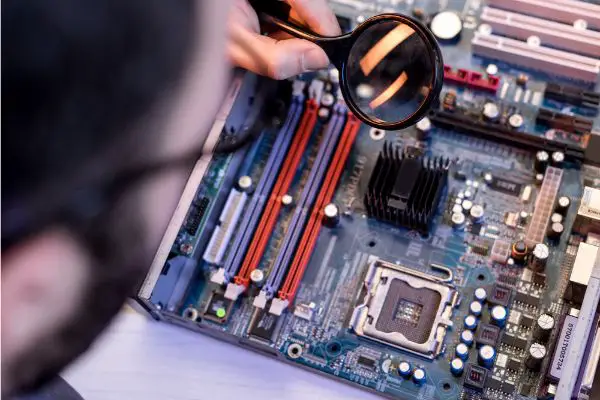Disclaimer: This post may contain affiliate links, meaning we get a small commission if you make a purchase through our links, at no cost to you. For more information, please visit our Disclaimer Page.
Computers are a part of our technology sector, and they represent one part that seems to be growing at an almost exponential rate. Although you can buy a perfectly good, brand new computer today for use that should last you several years, you would be able to upgrade that system to a new one within a year or so.
With that in mind, many users like to shop for discounted yet serviceable parts that they can put in their computers for years to come, and this is particularly true of people who want to build their own rigs. The motherboard is one such part. You can think of the motherboard as the main circuit board for a computer, and it is the primary way in which all of the other hardware inside the machine can send communications to and from each other.
Because it is such a vital component of a computer, many builders or everyday users wonder if purchasing a secondhand motherboard is okay. We will cover some nuances related to this topic in our article below.
We’ll talk about whether it is okay to buy motherboards in this condition, list some of the possible reasons why it might already be a popular choice with some users, and go over some of the tests you might do to see if the motherboard you decided to buy is in good working order. Furthermore, we’ll go the opposite way, bringing up some reasons why you may wish to avoid used boards.
Table of Contents
Is It OK To Buy a Secondhand Motherboard?
Whether it is fine to buy used motherboards can be both a contentious and personal topic. This can come down to your own preferences, but we will try to provide more objective reasons for use cases where you should or shouldn’t buy computer parts this way.
In the end, it is up to each person to decide if they are getting good value for their money here, but there are some benchmarks for which you can look in order to make this decision a little easier.
For most people in the tech community, buying a secondhand motherboard often depends on how much money you’ll save while ensuring that the component will work in your computer.
If you know that you can cut your price in half and still wind up with a serviceable unit, buying a used board like this may be worth it.
However, you’d want to ensure that the piece was compatible and able to last a long time. Otherwise, you will wind up with a board that may not work with your setup at all.
In other cases, you may find yourself with a motherboard that is already in poorer shape than you thought, and you’ll have to spend more money sooner than you think to get a working replacement.
In short, if you know the motherboard comes from a reputable source and are reasonably sure it is supposed to work, there is nothing particularly wrong with buying a used one.
The only thing that remains is to make a value judgment on the service you’ll be getting for the price you pay. If it is worth it to you, buying the board of your choice should be okay.
Why Do People Buy Used Motherboards? 5 Reasons
As we’ve touched on already, the motherboard is something of the foundation of everything else for your PC. It provides an interconnectedness that helps everything else function as it should.
Therefore, people new to purchasing used parts may wonder why some choose this route.
Of course, price is a major factor that we’ve alluded to when discussing value. Because of the functional nature of motherboards, they can be quite expensive. If you’re looking to build or upgrade your own system, here are a few of the reasons why you might buy a used motherboard:
1. You can sometimes get used motherboards in like new condition. This saves money and gives you a huge upgrade that can last for years.
2. Although this applies to more than just motherboards, users can help the environment by purchasing older but still functional parts.
The used piece might otherwise be in a landfill, and many such places incinerate their waste. To avoid this, you can buy used instead of new.
3. Some people want to use other powerful parts for less money. A used motherboard can help with this issue.
For example, a new motherboard that you can afford may not be able to run a higher RAM speed that you would like to put in your system.
However, you may be able to buy a used motherboard that is a higher specification than the new one for that same price. Doing so may allow you to put more upgrades in your system for less money.
4. Some used components have money-back guarantees that last for at least 30 days. If so, you have a few weeks to test your board or build your system. If something goes wrong, you can return it.
This gives you more flexibility to try out used parts without the risk of being stuck with them. However, not all motherboards from each place you can buy may have this guarantee.
5. Lastly, some people just want to build a working system with entirely used parts. Some builders like to do this just to see if they can make a rig full of secondhand components that can run just as well as a new one.
What Are Some Reasons for Not Buying a Used Motherboard?
Although there are several reasons why it isn’t a bad idea to buy a used motherboard, it comes with some caveats, too. Here are some of the main reasons why you may wish to avoid used motherboards:
1. As we touched on, individual sellers may not cover return warranties. Always look at the terms and conditions of the sale before you buy.
2. Certain parts of the motherboard do tend to wear out over time. The capacitors might be a prime example of this. If the board is old enough, you might be taking a risk on the shelf life remaining on its sensitive parts.
3. Delicate, exposed pins can bend or warp during shipping. You could have an already useless board on your hands when it arrives.
4. Larger parts can cost more to ship, lowering the potential value factor of buying used in the first place.
5. You may not know the board’s history, which can tell you a lot about the life it has left.
For example, a heavily overclocked board, or one that a user dedicated to mining all day may have a shorter life than a board that saw more use at normal settings and functions.
How Do I Test My Second Hand Motherboard?
Before we get into the specifics of testing a used board, it is important to understand that one needs a fully connected system to ensure that the board works as intended.
You can run some tests with just RAM, a central processor, and a good power supply if you don’t yet have a full system.
However, we recommend that you build or have a full system ready to perform a test that is as accurate as possible. Here are some basic guidelines you can follow for testing:
1. Follow the appropriate steps to install your motherboard into the rest of the rig. Ensure you have at least the minimum required parts we discussed earlier.
2. Power everything up to see if it works. The board should be fine to use if you get the right signals.
3. Although there isn’t much in the way you can use software, you may find some that will run a basic diagnostic to give you some answers.
Most such software requires some advanced computer understanding to interpret the messages you will see, however.
4. You may wish to run a stress test to see what the board can handle. In most cases, you can do this by overclocking everything that can be overclocked, run the computer for a while, and see how the board handles everything.
5. Check your system for other possible errors before you put the board in it. Doing so will allow you to eliminate the used motherboard as a possible source of problems.
What Are Some Signs of a Bad Motherboard?
Although they may not be conclusive, here are a few signs that could indicate a bad motherboard:
- If the motherboard fails, the computer may shut down right after booting up.
- You may get more blue screens if your used motherboard is having a problem.
- Devices connected to your computer that worked before you put in the used motherboard may no longer function properly.
- The CPU freezing or glitching out can result from motherboard issues, or the computer could restart unexpectedly.
Conclusion
Computer parts can be expensive nowadays, but you can save money with used ones. Although many people prefer to buy motherboards new, they are one such component that is okay to buy used, but you should know how to check for defects.
Many boards users buy this way will have warranty coverage, but you should ensure that the value you save in cost is worth the risk of any potential problems.


